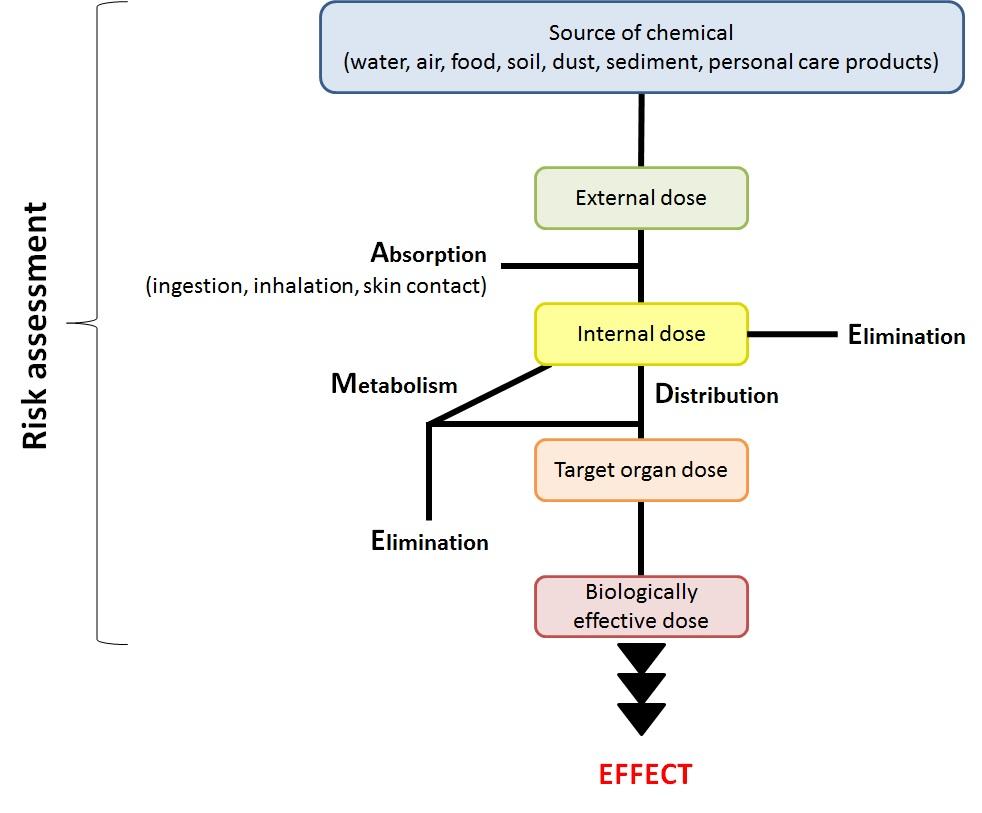|
[1]
|
Choi J, Mørck TA, Polcher A, et al. (2015) Review of the state of the art of human biomonitoring for chemical substances and its application to human exposure assessment for food safety. EFSA supporting publications 2015: EN-724. Available from: www.efsa.europa.eu/publications.
|
|
[2]
|
Knudsen LE, Hundeboll N, Merlo DF (2012) Chapter 1: Introduction to Human Biomonitoring; Knudsen LE, Merlo DF, editors. Cambridge, UK: The Royal Society of Chemistry.
|
|
[3]
|
Angerer J, Ewers U, Wilhelm M (2007) Human biomonitoring: state of the art. Int J Hyg Environ Health 210: 201-228. doi: 10.1016/j.ijheh.2007.01.024

|
|
[4]
|
Needham LL, Barr DB, Calafat AM (2005) Characterizing children’s exposures: beyond NHANES. Neurotoxicology 26: 547-553. doi: 10.1016/j.neuro.2004.09.006

|
|
[5]
|
Needham LL, Calafat AM, Barr DB (2007) Uses and issues of biomonitoring. Int J Hyg Environ Health 210: 229-238. doi: 10.1016/j.ijheh.2006.11.002

|
|
[6]
|
World Health Organization (2015) Human biomonitoring: facts and figures. Copenhagen: WHO regional office for Europe. Available from: http://www.euro.who.int/en/media-centre/events/events/2015/04/ehp-mid-term-review/publications/human-biomonitoring-facts-and-figures
|
|
[7]
|
Bocca B, Pino A, Alimonti A (2013) Metals as biomarkers of the environmental human exposure. EDP science 1: 3.
|
|
[8]
|
Schulz C, Wilhelm M, Heudorf U, et al. (2012) Reprint of “Update of the reference and HBM values derived by the German Human Biomonitoring Commission”. Int J Hyg Environ Health 215: 150-158. doi: 10.1016/j.ijheh.2012.01.003

|
|
[9]
|
Hays SM, Aylward LL (2012) Interpreting human biomonitoring data in a public health risk context using Biomonitoring Equivalents. Int J Hyg Environ Health 215: 145-148. doi: 10.1016/j.ijheh.2011.09.011

|
|
[10]
|
Pedersen M, Merlo DF, Knudsen LE (2007) Ethical issues related to biomonitoring studies on children. Int J Hyg Environ Health 210: 479-482. doi: 10.1016/j.ijheh.2007.01.013

|
|
[11]
|
Vikstrom AC, Warholm M, Paulsson B, et al. (2012) Hemoglobin adducts as a measure of variations in exposure to acrylamide in food and comparison to questionnaire data. Food Chem Toxicol 50: 2531-2539. doi: 10.1016/j.fct.2012.04.004

|
|
[12]
|
Esteban M, Schindler B, Jiménez-Guerrero J, et al. (2014) Mercury analysis in hair: Comparability and quality assessment within the transnational COPHES/DEMOCOPHES project. Environ Res: In press.
|
|
[13]
|
Castano A, Cutanda F, Esteban M, et al. (2015) Fish consumption patterns and hair mercury levels in children and their mothers in 17 EU countries. Environ Res: In press.
|
|
[14]
|
Centers for Disease Control and Prevention, National Health and Nutrition Examination Survey, 2015. Available from: http://www.cdc.gov/nchs/nhanes.htm.
|
|
[15]
|
Moshfegh AJ, Rhodes DG, Baer DJ, et al. (2008) The US Department of Agriculture Automated Multiple-Pass Method reduces bias in the collection of energy intakes. Am J Clin Nutr 88: 324-332.
|
|
[16]
|
Dwyer J, Picciano MF, Raiten DJ, et al. (2003) Collection of Food and Dietary Supplement Intake Data: What We Eat in America-NHANES. J Nutr 133: 590S-600S.
|
|
[17]
|
Centers for Disease Control and Prevention, National Report on Human Exposure to Environmental Chemicals, 2015. Available from: http://www.cdc.gov/exposurereport.
|
|
[18]
|
Statistics Canada, Canadian Health Measures Survey (CHMS), 2014. Available from: http://www23.statcan.gc.ca/imdb/p2SV.pl?Function=getSurvey&SDDS=5071
|
|
[19]
|
Health Canada, The Canadian Health Measures Survey, 2013. Available from: http://www.hc-sc.gc.ca/ewh-semt/contaminants/human-humaine/chms-ecms-eng.php.
|
|
[20]
|
Health Canada, Third Report on Human Biomonitoring of Environmental Chemicals in Canada — Results of the Canadian Health Measures Survey Cycle 3 (2012-2013), 2015. Available from: http://www.hc-sc.gc.ca/ewh-semt/pubs/contaminants/chms-ecms-cycle3/index-eng.php.
|
|
[21]
|
German Federal Environmental Agency, German Environmental Survey, GerES, 2014. Available from: http://www.umweltbundesamt.de/en/topics/health/assessing-environmentally-related-health-risks/german-environmental-survey-geres.
|
|
[22]
|
Schulz C, Seiwert M, Babisch W, et al. (2012) Overview of the study design, participation and field work of the German Environmental Survey on Children 2003-2006 (GerES IV). Int J Hyg Environ Health 215: 435-448. doi: 10.1016/j.ijheh.2012.02.002

|
|
[23]
|
Becker K, Seiwert M, Casteleyn L, et al. (2014) A systematic approach for designing a HBM pilot study for Europe. Int J Hyg Environ Health 217: 312-322. doi: 10.1016/j.ijheh.2013.07.004

|
|
[24]
|
Den Hond E, Govarts E, Willems H, et al. (2015) First steps toward harmonized human biomonitoring in Europe: demonstration project to perform human biomonitoring on a European scale. Environ Health Perspect 123: 255-263.
|
|
[25]
|
Schoeters G, Den Hond E, Colles A, et al. (2012) Concept of the Flemish human biomonitoring programme. Int J Hyg Environ Health 215: 102-108. doi: 10.1016/j.ijheh.2011.11.006

|
|
[26]
|
Flemish Center of Expertise for Environment and Health, Vlaams Humaan Biomonitoringsprogramma 2007-2011—Resultatenrapport: deel referentie biomonitoring, 2010. Available from: http://www.milieu-en-gezondheid.be/resultaten/referentiebiomonitoring.
|
|
[27]
|
French Institute for Public Health Surveillance, French Nutrition and Health Survey: the “ENNS Survey, 2006” - Nutritional situation in France according to public health objective indicators and recommendations of the French Nutrition and Health Programme (PNNS) - Summary of results, 2007. Available from: http://www.invs.sante.fr/content/download/20471/123869/version/1/file/enns_summary_results_2007_en.pdf.
|
|
[28]
|
Fréry N, Saoudi A, Garnier R, et al. (2010) Exposure of the French population to environmental pollutants—Environmental components of the French National Survey on Nutrition and Health -Initial results. French institute for public health surbeillange. Available from: http://opac.invs.sante.fr/doc_num.php?explnum_id=6867.
|
|
[29]
|
Pérez-Gómez B, Pastor-Barriuso R, Cervantes-Amat M, et al. (2013) BIOAMBIENT.ES study protocol: Rationale and design of a cross-sectional human biomonitoring survey in Spain. Environ Sci Pollut Res Int 20: 1193-1202.
|
|
[30]
|
Cañas AI, Cervantes-Amat M, Esteban M, et al. (2014) Blood lead levels in a representative sample of the Spanish adult population: The BIOAMBIENT.ES project. Int J Hyg Environ Health 217: 452-459. doi: 10.1016/j.ijheh.2013.09.001

|
|
[31]
|
Alimonti A, Bocca B, Mattei D, et al. (2011) Programme for biomonitoring the Italian population exposure (PROBE): internal dose of metals. Available from:
www.iss.it/binary/publ/cont/11_9_web.pdf.
|
|
[32]
|
Bocca B, Mattei D, Pino A, et al. (2010) Italian network for human biomonitoring of metals: preliminary results from two Regions. Ann Ist Super Sanita 46: 259-265.
|
|
[33]
|
Cerna M, Krskova A, Cejchanova M, et al. (2012) Human biomonitoring in the Czech Republic: an overview. Int J Hyg Environ Health 215: 109-119. doi: 10.1016/j.ijheh.2011.09.007

|
|
[34]
|
Puklova V, Krskova A, Cerna M, et al. (2010) The mercury burden of the Czech population: An integrated approach. Int J Hyg Environ Health 213: 243-251. doi: 10.1016/j.ijheh.2010.02.002

|
|
[35]
|
Mikeš O, Cupr P, Kohut L, et al. (2012) Fifteen years of monitoring of POPs in the breast milk, Czech Republic, 1994-2009: trends and factors. Environ Sci Pollut Res Int 19: 1936-1943. doi: 10.1007/s11356-012-0798-z

|
|
[36]
|
The Czech Republic National Institute of Public Health, Environmental Health Monitoring, Available from: http://www.szu.cz/topics/environmental-health/environmental-health-monitoring?lang=2.
|
|
[37]
|
Lee JW, Lee CK, Moon CS, et al. (2012) Korea National Survey for Environmental Pollutants in the Human Body 2008: heavy metals in the blood or urine of the Korean population. Int J Hyg Environ Health 215: 449-457. doi: 10.1016/j.ijheh.2012.01.002

|
|
[38]
|
Lee K-M, Kho Y, Chun JB, et al. (2011) Urinary levels of phthalate metabolites in Korean population: KorSEP data, 2009. Available from: http://khis.khu.ac.kr:9090/SummonRecord/FETCH-kiss_primary_32297243.
|
|
[39]
|
Sul D, Ahn R, Im H, et al. (2012) Korea National Survey for Environmental Pollutants in the human body 2008: 1-hydroxypyrene, 2-naphthol, and cotinine in urine of the Korean population. Environ Res 118: 25-30. doi: 10.1016/j.envres.2012.07.010

|
|
[40]
|
De Felip E, Bianchi F, Bove C, et al. (2014) Priority persistent contaminants in people dwelling in critical areas of Campania Region, Italy (SEBIOREC biomonitoring study). Sci Total Environ 487: 420-435. doi: 10.1016/j.scitotenv.2014.04.016

|
|
[41]
|
Region Skåne, Aktuellt om PFAS [News about PFAS], 2015. Available from: http://www.skane.se/sv/Webbplatser/Labmedicin_Skane/Verksamhetsomraden/Arbets--och-miljomedicin/Aktuellt-om-PFAS/.
|
|
[42]
|
Kucera J, Bencko V, Sabbioni E, et al. (1995) Review of trace elements in blood, serum and urine for the Czech and Slovak populations and critical evaluation of their possible use as reference values. Sci Total Environ 166: 211-234. doi: 10.1016/0048-9697(95)04425-Z

|
|
[43]
|
Landrigan PJ, Etzel RA (2014) Textbook of Children's Environmental Health; Landrigan PJ, Etzel RA, editors: Oxford University Press. 608 p.
|
|
[44]
|
World Health Organization, Possible developmental early effects of endocrine disupters on child health, 2012. Available from: http://www.who.int/iris/bitstream/10665/75342/1/9789241503761_eng.pdf.
|
|
[45]
|
Becker K, Müssig-Zufika M, Conrad A, et al. (2008) German Environmental Survey for Children 2003/06-GerES IV, Human Biomonitoring-Levels of selected substances in blood and urine of children in Germany. Available from: http://www.umweltbundesamt.de/en/publikationen/german-environmental-survey-for-children-200306.
|
|
[46]
|
National Academy of Sciences (1993) Pesticides in the diets of infants and children. Washington DC, USA: National Academies Press.
|
|
[47]
|
Barker DJ (2004) The developmental origins of adult disease. J Am Coll Nutr 23: 588S-595S. doi: 10.1080/07315724.2004.10719428

|
|
[48]
|
Ginsberg G, Hattis D, Sonawane B, et al. (2002) Evaluation of Child/Adult Pharmacokinetic Differences from a Database Derived from the Therapeutic Drug Literature. Toxicol Sci 66: 185-200. doi: 10.1093/toxsci/66.2.185

|
|
[49]
|
Becker K, Goen T, Seiwert M, et al. (2009) GerES IV: phthalate metabolites and bisphenol A in urine of German children. Int J Hyg Environ Health 212: 685-692. doi: 10.1016/j.ijheh.2009.08.002

|
|
[50]
|
Calafat AM, Wong LY, Silva MJ, et al. (2011) Selecting adequate exposure biomarkers of diisononyl and diisodecyl phthalates: data from the 2005-2006 National Health and Nutrition Examination Survey. Environ Health Perspect 119: 50-55.
|
|
[51]
|
Kolossa-Gehring M, Becker K, Conrad A, et al. (2008) Exposure of Children to Chemicals, Biological Factors and Noise—the German Environmental Survey on Children (Geres IV). Epidemiology 19: S288.
|
|
[52]
|
Huang W, Caudill SP, Grainger J, et al. (2006) Levels of 1-hydroxypyrene and other monohydroxy polycyclic aromatic hydrocarbons in children: a study based on U.S. reference range values. Toxicol Lett 163: 10-19.
|
|
[53]
|
Li Z, Sandau CD, Romanoff LC, et al. (2008) Concentration and profile of 22 urinary polycyclic aromatic hydrocarbon metabolites in the US population. Environ Res 107: 320-331. doi: 10.1016/j.envres.2008.01.013

|
|
[54]
|
Lunder S, Hovander L, Athanassiadis I, et al. (2010) Significantly higher polybrominated diphenyl ether levels in young U.S. children than in their mothers. Environ Sci Technol 44: 5256-5262.
|
|
[55]
|
Toms LML, Calafat AM, Kato K, et al. (2009) Polyfluoroalkyl chemicals in pooled blood serum from infants, children, and adults in Australia. Environ Sci Technol 43: 4194-4199. doi: 10.1021/es900272u

|
|
[56]
|
Fischer D, Hooper K, Athanasiadou M, et al. (2006) Children Show Highest Levels of Polybrominated Diphenyl Ethers in a California Family of Four: A Case Study. Environ Health Perspect 114: 1581-1584. doi: 10.1289/ehp.8554

|
|
[57]
|
Risher JF, Todd GD, Meyer D, et al. (2010) The elderly as a sensitive population in environmental exposures: making the case. Rev Environ Contam Toxicol 207: 95-157.
|
|
[58]
|
Croes K, De Coster S, De Galan S, et al. (2014) Health effects in the Flemish population in relation to low levels of mercury exposure: from organ to transcriptome level. Int J Hyg Environ Health 217: 239-247. doi: 10.1016/j.ijheh.2013.06.004

|














 DownLoad:
DownLoad: